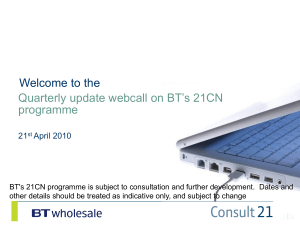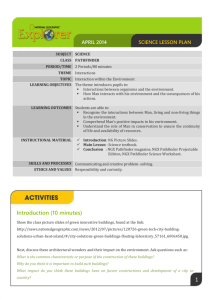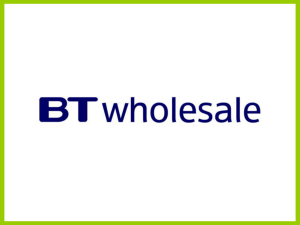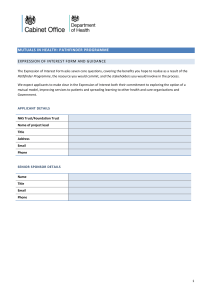C21 updates for 17th Oct web call
advertisement
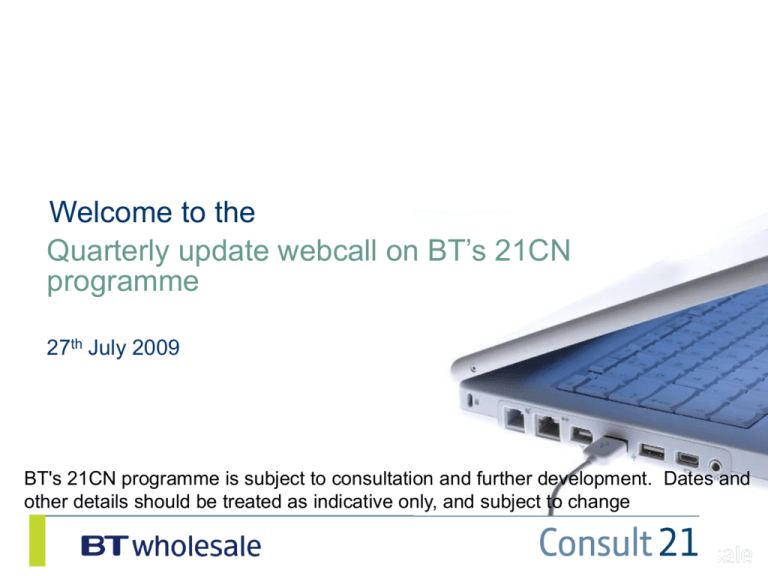
Welcome to the Quarterly update webcall on BT’s 21CN programme 27th July 2009 BT's 21CN programme is subject to consultation and further development. Dates and other details should be treated as indicative only, and subject to change Agenda 21CN Deployment Strategy Plan (DSP) • Key information & changes Pathfinder Volume POTS & network upgrades 21CN Broadband update • IPstream & Datastream withdrawal • BTW FTTC pilot Industry consultation evolution Consult21 activities • Key activities • MSIL resilience update Q&A and poll Speakers: Nigel Scott, Carole Haywood-Poole, Felicity Webster, Bill du Cann 21CN Deployment Strategy Plan (DSP) - Key information & changes Nigel Scott BTW, Industry Consultation BT's 21CN programme is subject to consultation and further development. Dates and other details should be treated as indicative only, and subject to change 21CN Deployment Strategy Plan (DSP) - intro • The DSP (C21-MG-015)* was issued on 15th July 09 • Published for the first time with the 21CN Product Plans incorporated (previously published separately as C21-MG-016) • Provides CPs with the 21CN strategy, roadmaps, definitions and sequencing and timing information for the future development of BT’s 21CN programme and provides a framework for our consultations • Key objectives are unchanged since the April issue NB: Held in the secure area - access is only available to our CP customers – for access please email consult21@bt.com 21CN Deployment Strategy Plan (DSP) - changes • Since our last quarterly webcall the first phase of Pathfinder has successfully completed • 21CN network performance and call quality is good and circa 2.5 million calls are carried over the network per week • The proposed 21CN timetable has been updated to reflect the latest Pathfinder news including dates / scope of next phase known as Pathfinder Volume POTS • Detailed section on the network upgrades (Call Server & CMSAN) with network affecting activities & impacts on end users 21CN Deployment Strategy Plan (DSP) - changes • The Pathfinder voice trials strategy has been clarified into key elements:• • • • • • • Pathfinder1 (current South Wales deployment of up to 75k lines) Pathfinder Volume POTS (previously referred to as Pathfinder 275k) Huawei ISDN Service Trial (a BT own-use service trial at 3 national sites using Huawei MSANs) Huawei Northern Ireland (migration of POTS/ISDN customers) Fujitsu ISDN Service Trial (a BT own-use service trial at nominated Pathfinder sites in South Wales using Fujitsu MSANs) Pathfinder Volume All Voice Products (previously known as Thamesmead and Redditch) Pathfinder ISDN (migration of ISDN customers on the Pathfinder exchanges in South Wales) • The previous term of Pathfinder+ will no longer be used 21CN Deployment Strategy Plan (DSP) – product overview updates • WBC is now available at 549 sites – approx 40% of households coverage (10m homes & businesses) • Plan to extend the WBC footprint to up to 55% of households, subject to demand by end March 2010 • IPstream and Datastream work on replacements and withdrawals in favour of the WBC family have continued • WBC enhancements for greater line speed (ADSL2+) and real time (QoS) • TDM progress continuing against feasibility studies running • NGN CC now subject to customer bilateral meetings to determine optimum launch window • ISDN – progressing work on (BT) own use trials Pathfinder Volume POTS & network upgrades Nigel Scott Carole Haywood-Poole BT's 21CN programme is subject to consultation and further development. Dates and other details should be treated as indicative only, and subject to change Pathfinder – the next steps – Pathfinder Volume POTS • Again voice migrations only • Will complete the further 7 DLEs in South Wales - Cardiff, G, L, E, F, Bridgend, Cardiff B, Pontypridd • Will complete the migration of up to 350K lines • Migrations will take place January 2010 through to July 2010 • Same technology & architecture as Pathfinder – Ericsson based call server • August - October 2009 - Call Server and MSAN upgrades in Pathfinder area • Will provide key learning following migration of a complete DLE in a night Upgrades planned in the South Wales area • Upgrades are planned between August and October 2009 when there will be short voice line outages for end users • We have worked extensively with the vendors to minimise the impact to customers for example upgrades will be performed in the early hours of the morning to minimise the impact • In summary, each customer will experience outages on three different nights. On one night there will be two outages. Two nights, where call server* upgrades will affect customers One night, where the MSAN* upgrade will cause two impacts. * See notes pages for definitions Upgrade programme – main benefits The programme of upgrades in the summer will provide a number of key benefits: Reduces customer down time for future upgrades. Resolves a number of customer premise equipment incompatibility issues. Prepares the area for further volume voice line migrations. Summary of upgrade impacts on end users Cause Timing Experience Scale End users moved to standby call server Between midnight & 6am. 2 minutes incoming & outgoing call outage for all customers. calls in progress will be cut off. Star Services Freeze Midnight to 6am. Impacts circa 30K end users simultaneously. End Users moved back to primary call server Between midnight & 6am, 3 weeks after the first impact for CS (a) upgrade and 2 weeks after the first impact for the second CS (b) As above As above MSAN upgrade-first impact. Between midnight & 6am (10 mins elapsed time) Between 3am-5am, 5 minutes incoming & outgoing call outage for all customers simultaneously calls in progress will be cut off. No Star Services freeze Only one MSAN Site will be completed per night. MSAN upgrade second impact On the same night between 1 and 30 mins after MSAN upgrade- first impact 2 minutes incoming & outgoing call outage for all customers in batches of 5 linecards, successively until all linecards have been upgraded. Calls in progress as a linecard is upgraded will be cut off. No Star Services freeze Impacts all end users on an MSAN site, in batches (max 320 at a time) Upgrades planned in the South Wales area • There will be no switched-on end user communications about the upgrades • However the switched-on call centre team will be kept fully informed in case of enquiries etc 21CN Broadband update - IPstream & Datastream withdrawal - BTW FTTC pilot Felicity Webster BTW, Industry Consultation BT's 21CN programme is subject to consultation and further development. Dates and other details should be treated as indicative only, and subject to change Consultation overview • First phase of IPstream consultation operated during summer 2008 and was concluded in February 2009 – – • Second phase of IPstream consultation (EUA withdrawal) started in May 2009 – – – • Confirmed two stage withdrawal framework • Stage 1 – Centrals • Stage 2 – End User Access (EUA) Identified dependencies for withdrawal of Centrals Proposed withdrawal framework was shared with CPs as part of an Industry workshop held on 21st May Formal consultation document (CONDOC) was published on 10th June Bi-laterals have been held during June/July in conjunction with the formal CONDOC Datastream consultation has been ongoing since January 2009 and is now drawing to a conclusion – Series of detailed workshops have supported the formal CONDOC – Framework for product withdrawal and new supply options have now been determined – Continued discussions and migration planning will be conducted bi-laterally with Datastream customers IPstream Consultation Example timeline for withdrawal of IPstream Centrals Migration from and full withdrawal of Centrals Withdrawal of new supply of Centrals Launch of 1Gb Host Links Consumption of IPSC via WBMC Launch of 100Mb Host Links or equivalent product 6 mths 12 mths Proposed framework for EUA withdrawal Exchange withdrawal notification individually or in groups 6 months Withdraw from sale at exchange locations included in notification Exchange withdrawal notification individually or in groups **BT’s analysis shows that if all CPs wait until withdrawal notification before starting their migrations, then some exchanges that have large aggregated volumes of EUs may require longer than 12 months for full migration 6 months 12 months Withdraw from sale at exchange locations included in notification Exchange withdrawal notification individually or in groups 6 months Withdraw of service at exchange locations included in notification 18 months** Withdraw from sale at exchange locations included in notification 12 months Withdraw of service at exchange locations included in notification Withdraw of service at exchange locations included in notification This process will operate on a continuous basis until service has been withdrawn from all exchanges Datastream Consultation Proposed Datastream product withdrawal timeline Datastream product withdrawn nationally National Product Withdrawal Notice issued No further supply of New End User Access No further 20C Exchanges Datastream enabled No further supply of New CALs & BBLCs All End Users, Virtual Paths & Backhaul removed from network No further supply of New Virtual Paths Alternative services available for all Datastream EUs – for minimum 6 months 1 2 3 4 5 6 7 8 9 10 11 12 13 14 15 16 17 Months National product withdrawal notification to be issued 18 months in advance. Datastream product withdrawal notice will not be issued before June 2010 Committed 18 Next steps – bi-lateral framework Proposed framework for bi-laterals: • CPs strategy/aspirations for their end users – What is the proposition for each type/segment – Explore mapping that may offer ‘like for like’ options or create upsell opportunities • Adding value through additional features • Retaining customer through contract extension – Analysis of footprints available for WBC (incl. FTTC) and EFM • Commercial case and how can the move happen? – Understand when the ‘tipping point’ might be reached – Opportunities for rationalisation of networks/infrastructure – Dual running to Treble running to Dual running – Timing and process for migrations • CPs to contact simon.brisbourne@bt.com or consult21@bt.com to request a bi-lateral WBC/WBMC FTTC trial BT Group’s strategy • BT plans the biggest ever UK investment in fibre-based super-fast broadband Subject to the right regulatory environment • In July 2008, BT announced its plans to rollout fibre-based, super-fast broadband to end users – Up to 10 million UK homes by December 2012 – Up to £1.5billion investment – Mixed economy strategy • At Q4 results (May 2009), BT announced the acceleration of its plans – FTTC in reach of more than one million homes & businesses by Spring 2010 • BT will offer fibre access on an open, wholesale basis BTW WBC/WBMC FTTC proposition Fibre access overlay incorporated into WBC. a single interface via WBC/WBMC for all types of access – Including FTTC up to 40Mb downstream and up to 2Mb upstream (optional up to 5M). a network with predictable behaviour that will support applications – Video telephony – Multiple lines into the home/business. – High quality voice. – High speed surfing. – Video streaming. NEXT GENERATION BROADBAND - ‘Mixed economy’ access blend Exchanges Homes/Businesses Copper Up to Copper 24Mbit/s FTTC/Fibre to the cabinet Up to 40Mbit/s Fibre with improved upstream rates FTTP/Fibre to the premise Up to 100Mbit/s Copper Cabinet Fibre + with improved upstream rates Mobile Up to 7.2Mbit/s LTE/4G promises higher mobile broadband speeds Mobile Mobile Mobile Network WHAT IS WBC FIBRE TO THE CABINET WBC FTTC is provided by a DSLAM located in the street rather than in the exchange. The DSLAM is then connected to the exchange by a fibre. PSTN service continues to be offered over the copper pair. This can offer much higher Broadband line rates to End Users using VDSL 2 technology. Street Level Exchange Level ADSL2+ MSAN Network Node VDSL2 FTTC GEA POH Node L2S FTTP/GPON Aggregation Point (x 20) 21C BRAS (~1000) Backhaul MSIL BTW - WBMC (MPLS/DWDM) Communication Provider A 20C BRAS ADSL1 DSLAM WBC Customers will be able to have service delivered Via WBC ADSL 2+ or FTTC Questions Answers Industry consultation evolution Bill du Cann BTW, Industry Consultation Summary of the evolution: • • • The Industry Consultation team is widening its remit - the type of engagement is evolving We need to reflect those changes in the way we are structured There will now be 3 distinct workstreams – Consult21 – delivery of 21CN plan, 21CN obligatory product consultation – Customer Experience - driving through CE improvements to ensure an excellent customer experience for CPs – (3rd work stream) – collaboration with industry on non-obligatory product developments or new requirements • • • The team’s objectives of awareness, engagement and influence are relevant to all 3 workstreams, still the voice of the customer within BT Engagement in the 3rd workstream will be in a similar format – bi-laterals & expert groups where appropriate Provides a clear on the context of our discussions and consultations New requirements & products development Consult21: Customer Experience 21CN DSP & SMP obligations Objectives of the workstreams • Deliver the 21CN workplan, facilitate 21CN migrations and obligations • Improve the effectiveness of consultation & customer influence on the 21CN plan • Provide customer insight to inform portfolio and product roadmaps for obligatory products • Ensure BT Wholesale is truly listening to customer requirements relating to end to end Customer Experience • Help BT to achieve its goal of being number 1 for customer service • Identify and gain commitment to resolution of generic CE issues and establish priority areas for investment in CE improvements Examples of Work areas• • Pathfinder • WLR migration • PC strategy • MSIL • 20CN Broadband withdrawal • • • C2M Roadmaps Systems Interfaces & usability Billing • To improve customer collaboration on nonobligatory products. • To introduce new areas for discussion outside of delivering the 21CN workplan. • Provide customer insight to inform portfolio and roadmaps for non-obligatory products. • Converged Business Services discussions • BB evolution – inc SFBB & voice over broadband What does / doesn’t change? • Consult21 remit doesn’t change • The Consult21 Steering Board remains unchanged for Consult21 activities & will continue to function as an escalation point for issues under this workstream • The Portfolio working group is disbanded, expert groups that sat under this working group remain (if relevant to this workstream) • You will see some changes to documents & information – these will be proposed at the July Steering Board and if agreed further communications will follow • Keep an eye out for further briefings on the evolution Key Consult21 engagement activities Bill du Cann BTW Industry Consultation BT's 21CN programme is subject to consultation and further development. Dates and other details should be treated as indicative only, and subject to change Multi Service Interconnect Link (MSIL) - resilience Ethernet MSIL provides the transparent Ethernet link between the Point of Handover to/from the CP’s network and the Multi-Service Access Port (MSAP) on BT’s Ethernet Edge Aggregation device (EEA). As such it allows CPs to access BT's range of IP based services on the 21CN MSIL resilience possibilities CP Area/ Equip or ISH Openreach Cable Link Resilient Option Subject to development request KEY: = EEA Main Chassis & core components = IOM = 10-Port GE MDA = GE SFP Optics Module = 1-Port 10GE MDA MSIL Patch Panel Connection to Core Network MSIL resilience progress • MSIL product launched in basic form in 2008 • Feedback from customer workshops (primarily at Broadband) identified the need for a resilient variant • A formal consultation was run during Spring 2009 to confirm requirements • Key requirements noted are: – Resilient Access to be available via separate EEAs at all core sites providing broadband interconnection. – At Non- Core sites, resilience to be provided to at least the level of separate MSIL cards and IOM, if separate EEAs not available (due to limited capacity requirements). – A PEW is not undertaken at the same time for different EEAs at the same site. – Resilience must be retained during the life of the MSILs. • Next steps – Feasibility study has been initiated – Design touch-point meetings with interested CPs to be run during 2009 – Looking for product delivery in early 2010 Consult21 headlines Consult21 News CE systems & process interface workshop held Consult21 forthcoming activities Consult21 News TDM sub 2Mbit/s feasibility results Consult21 News Pathfinder Volume POTS preparation – be involved How to get engaged with Pathfinder Volume POTS • By attending the Consult21 Implementation and migration working group (IMWG) • By attending the Pathfinder expert groups • By attending the regular Pathfinder progress update audios (held every Thursday) • By attending the Pathfinder summary webcalls (next one 4th September 09) • Read the C21-IM-011 on how we conducted the Pathfinder review • Check out the pre-migration process via C21-IM-035 Useful information & how to get engaged More information? then contact helen.nurse@bt.com Or visit these sites The Consult21 website: www.btwholesale.com/consult21 The independent public information website covering the process of migration: http://www.switchedonuk.org For general information about BT’s 21CN programme go to: http://www.btplc.com/21CN/ Questions Answers Any hot topics for future webcalls? If you have any hot topics for future 21CN webcalls please email:Consult21@bt.com Please help us to improve future webcalls by answering a few poll questions Thank you for coming on the call
